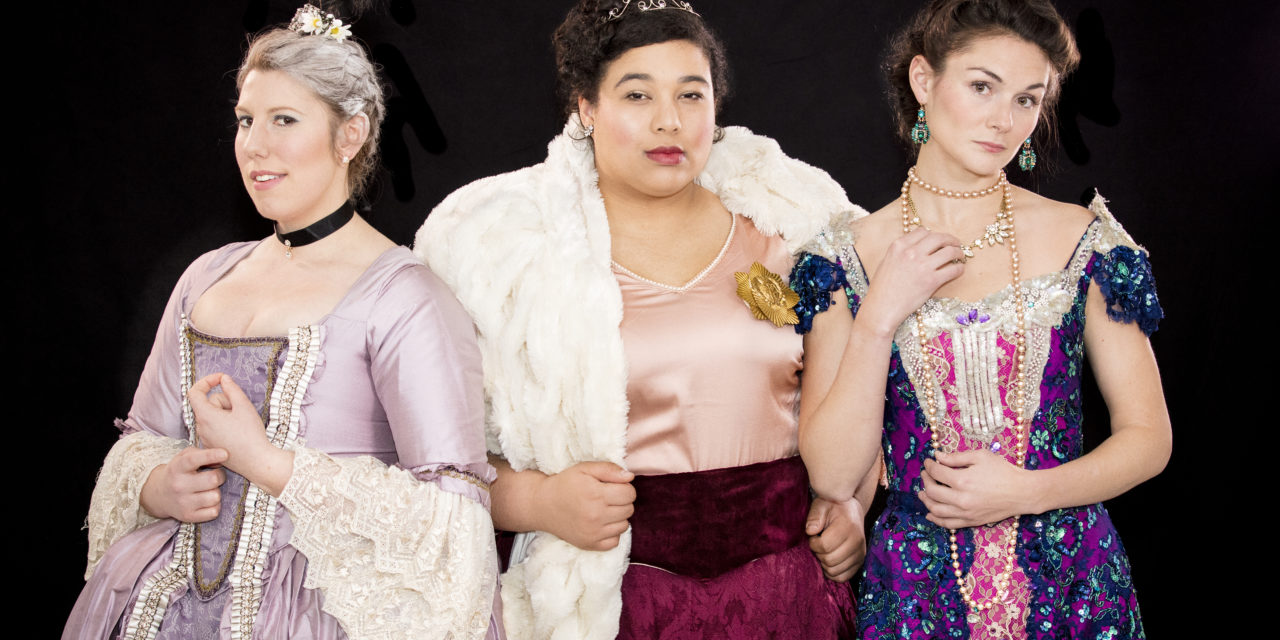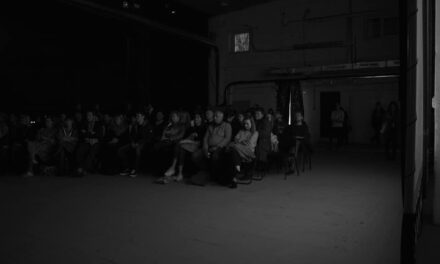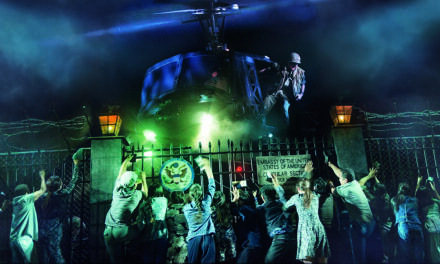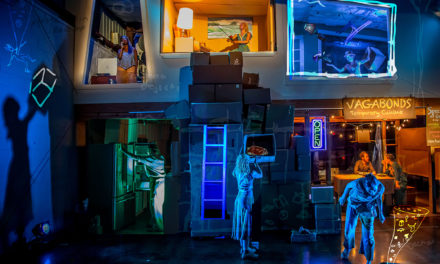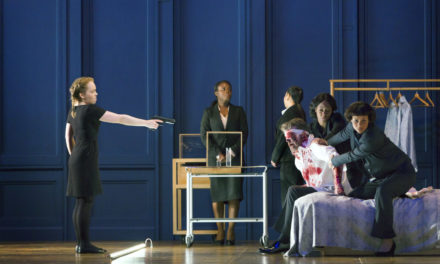This week, OperaHub’s original DIVAS, a “World Premier play with opera music” opens June 21st and runs through June 30th at the Boston Center for the Arts Plaza Theatre. Featuring nine contemporary singers portraying historical divas spanning three centuries, the original piece has been a work in progress from concept to reality for several years. I sat down in the “Diva Museum” at the home of Kathleen McDermott, Fashion Historian and Visual Artist, whose extensive research and lectures inspired the work.
Adrienne Boris, Producer and stage director, playwright, Laura Neill, and Arielle Rogers, mezzo-soprano, made up the rest of this group of dynamic women involved in the production, the first of its kind for the company.
Katrina Holden-Buckley (KH): Kathy, can you tell us about your ten years of research on these historical divas and the beginnings of this project?
Kathleen McDermott (KD): I teach fashion history at MassArt, and I’m always looking for images to show my students and one of the things that struck me was the enormous set of imagery left behind by the great singers captured by the greatest painters and photographers. The key thing is that they’re always dressed in the latest silhouette. As I began to notice how many there were I started researching them and came to find out that these were extraordinary lives way in advance of women of their time. That’s the personal piece. As I continued to study them, I learned that there’s a much larger story. I ended up studying twenty-six of them, and it’s not just a story of individuals creating great careers, but a story of a group of women who in their careers push the agenda of Western women forward.
KH: Adrienne, talk a little bit about OperaHub and its place in the city.
Adrienne Boris (AB): OperaHub has been in operation since 2007 and Christie Gibson has been the artistic director since 2012. It produces innovative accessible chamber opera in Boston and up until this production, everything we have presented has been free of charge and open to the public. Christie went to one of Kathy’s lectures in 2015. Christie was struck by the notion that the lives of these women would make a really interesting theatre piece of some kind and the notion that as a company we have always tried to prioritize and discuss is the number of roles for women, the quality of roles for women, and the representation of women. We hadn’t really been finding the right piece to showcase all of the fabulous women in the OperaHub roster. We began meetings for this in September 2016. Kathy worked with the singers to give them the resources to kind of claim their divas. Over the course of about 6 months, the singers became experts on their divas and would be in dialogue with Laura about how their characters would be portrayed, so it’s been a collaborative process since them.
From the producer perspective, the piece is really a deliberate strike at the problem in the contemporary opera industry of a real dearth of interesting, representative roles for women, both in terms of quality and quantity and the ways in which the roles do not represent the breadth and depth of the female experience.”
KH: Laura, coming in as the playwright, this process was obviously very different from what you’re used to. Can you speak to that a little bit?
Laura Neill (LN): Obviously, we started with Kathy’s research and I was tasked to create an empowering show about these [nine] women. We started this process in 2016 and one of the things we’ve seen is the way our country views artists shift or reveal itself, shall we say, over that time. So being in the room with the collaborators, I wasn’t only listening when they were talking about their divas, I was listening when they were talking about their lives as contemporary opera singers. The show ended up becoming this piece that not only educates us about the past but pushes us towards, “Ok, where do we go next?” As far as me as a playwright, I had never written anything to do with opera before.
KH: So you had some catching up to do?
LN: I did. And luckily, each singer becoming an expert on her diva, I could lean into what aspects they were interested in.
KH: Speak a little bit to the political environment and how things have teased out themes that may not have been there before.
LN: About midway through this process, it came out that there was a plan to eliminate the NEA completely. Of course, since then, its received its funding for the next year, but that hit our group a bit hard not just in terms of OpeaHub’s funding but also in terms of a symbolic priority.
KH: And there have to be some ties between these divas themselves and the way they were compensated.
LN: Yes, well the divas weren’t actually allowed to own property or possess wealth and that’s one of the reasons for the fabulous costumes, because if you can’t have money but you can own dresses…
AB: …And jewels as hard money.
LN: And I think what we’re looking at today that connects to that is that there is this absolute lack of funding for the arts in our country and you grab onto what you can–this sort of resourcefulness and create something out of nothing. It was also really educational to me to hear the singers talking about the whole structure of how one makes an opera career. For every great story of someone who rose above there are still a lot of little people at the bottom still trying to make it and I think that spirit has pervaded this process as well.
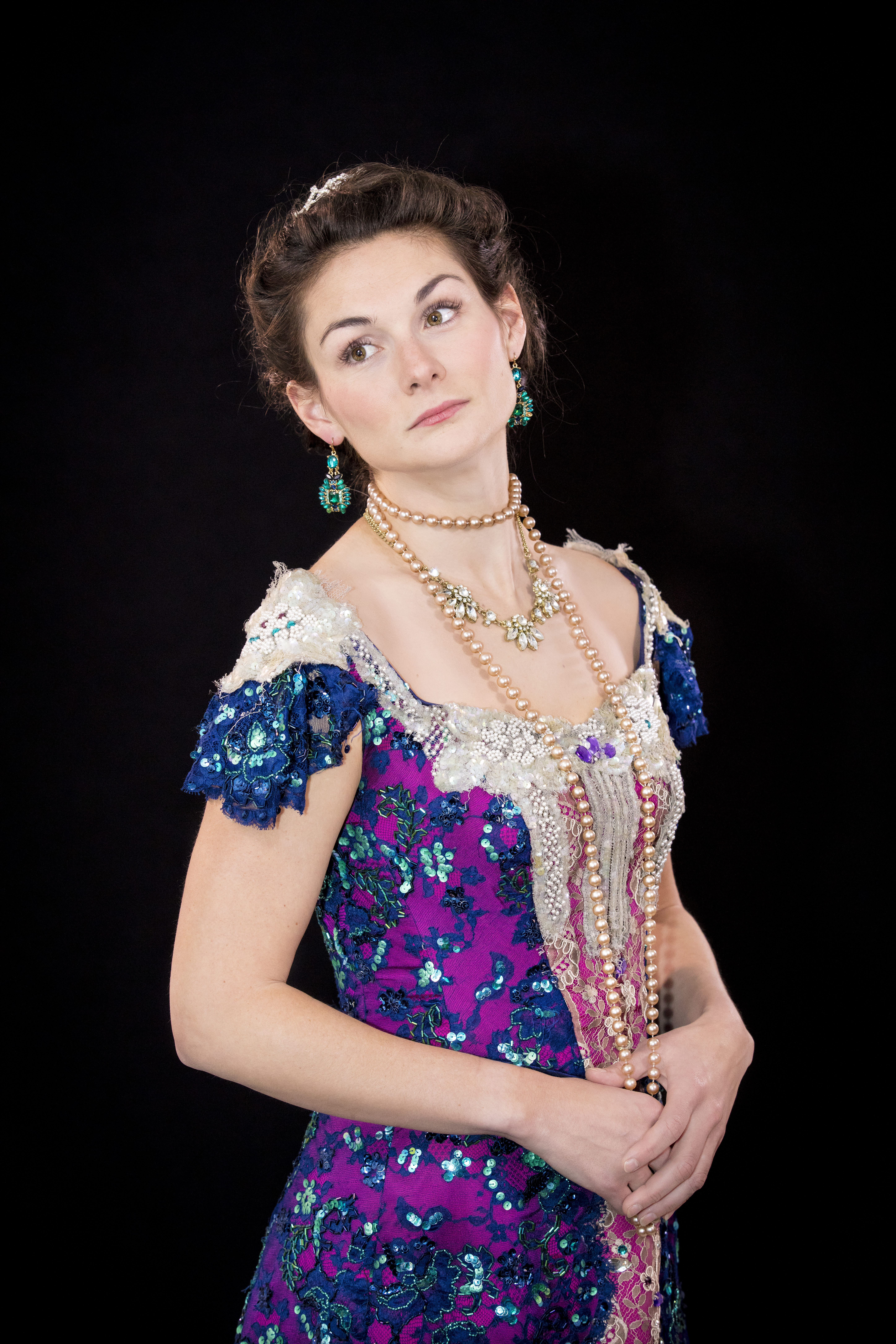
Photo by T-Stop Pictures
KH: Was there anything that surprised any of you about the lives of these divas?
LN: I think one thing that struck me, coming from the theatre was how incredibly young a lot of these singers were when they started. Most of the divas started at an incredibly young age. Some of them were supporting their entire families.
AB: For me there are a couple of things; one is the idea of singing being about survival, which is way different than our culture today and the idea that they were revered onstage and it was perfectly acceptable for men to throw jewels at them, and yet as far as respectable society [was concerned], they were complete outcasts. One more specific thing is that there are so many diva stories that I’ve learned about, but I think Maria Malibran’s story stuck with me the most. She died very young at 28 in a horseback accident. It is believed now that she suffered from depression and bipolar disorder and none of that was understood at the time. She also was trained at knifepoint by her father, [also Pauline Viardot’s father because they were sisters]. Just this idea that she was a wild and passionate artist, but also what that might have meant for her mental state.
KH: Arielle, I want to talk a little bit about your diva. What in the process was most interesting or most surprising or most identifiable?
AR: I’m very fortunate to play and have learned so much about Sissieretta Jones [1869-1933]. She was an African American opera singer and I think the best way to describe her would be that she was a force of nature who was never known. Sisieretta was raised in Providence where I myself live it’s also where she ended up dying. She was this extraordinary diva who traveled the world and she died penniless as a cook in Providence. She’s buried literally a mile from my house so I’m super connected to her.
AB: When I called Arielle about the project and mentioned some of the divas we were looking into, she was like “As it happens, I wrote my thesis on Sisieretta Jones.”
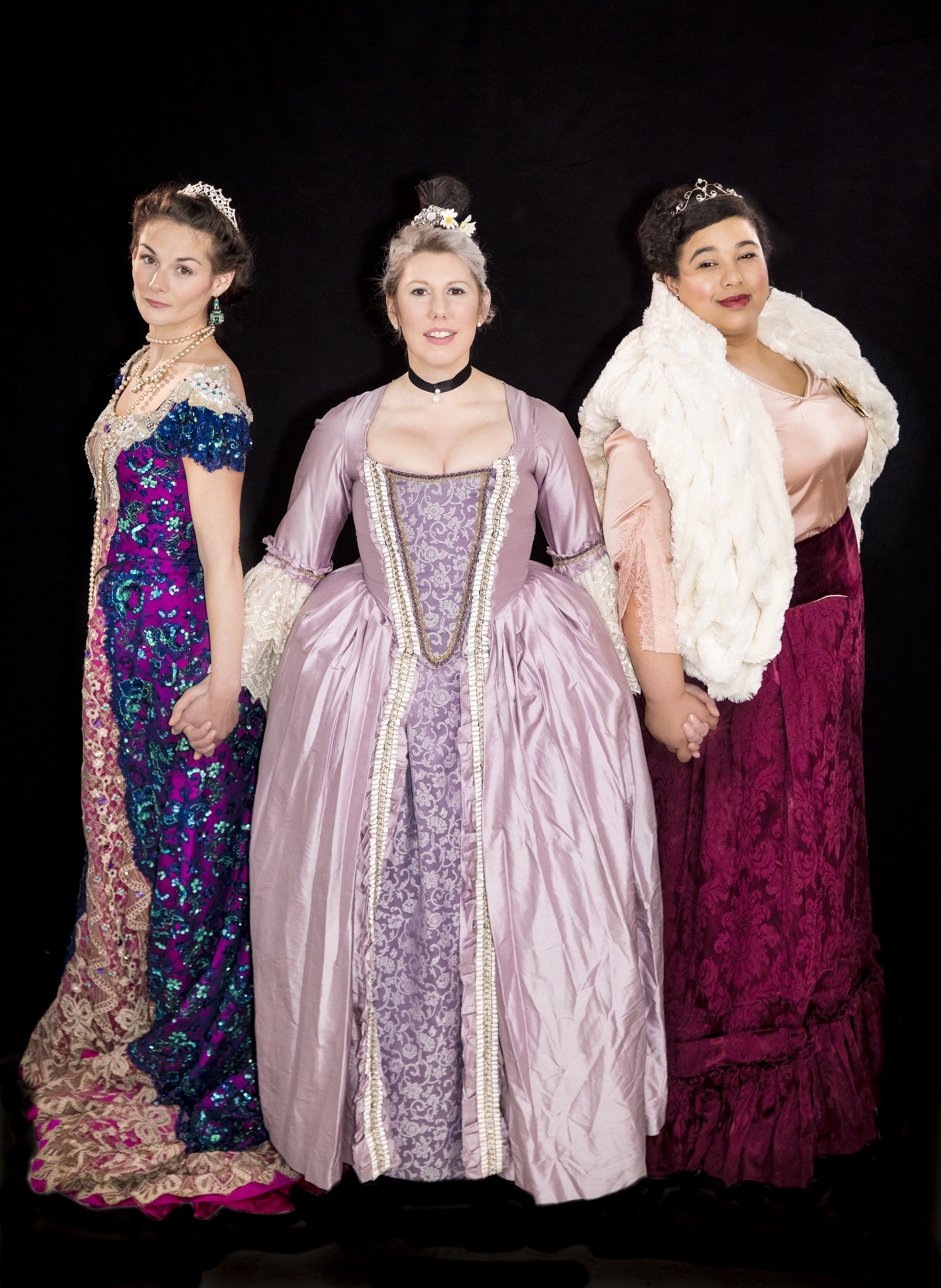
Kathryn McKeller, Lindsay Conrad, and Arielle Rogers bring historical divas to life in OperaHub’s upcoming production DIVAS by Laura Neill. Photo by T-Stop Pictures.
KH: That’s interesting because you don’t hear her name among the singers like Marian Anderson or Leontyne Price or the early African American opera singers.
AR: Well, she never actually sang a full opera. But, she did way more than just opera as we know it as a genre. She sang folk songs and Americana based music. I think a lot of the divas did that in their own respective places, but a lot of it was also due to the fact that she was black and so she was not able to perform in much of Jim Crow America. She was known often as “The Black Patti” – the black version of Adelina Patti.
AB: Her troupe was called “The Black Patties” also.
And it’s an unfortunate name, but she took it and made her opportunities with it. Laura does a beautiful job of, right off the bat, showing that her biggest obstacle compared with the other divas is just the color of her skin. Even though she often had white management and white orchestras, they were staying at the Ritz and she would have to stay at the equivalent of a Motel 6.
KD: In “The Black Patty Troubadors,” she was the headliner, and her act was called an operatic kaleidoscope, in which she sang opera arias backed by many singers and an orchestra. So she presented to black audiences, these mini aria concerts. People who have studied the Harlem Renaissance say that she ran that thing for 20 years and the amount of creative African Americans who came out of that troupe is enormous.
KH: And to be entirely led by a woman as well!
AR: There are some who say she and her group actually gave birth to the Harlem Renaissance. The Troubadors weren’t just a couple of singers; we’re talking dozens and dozens of singers, dancers, jugglers, it was truly a very fine circus with opera at the end. It was a variety show at its finest. She played Madison Square Garden! This was how big she was in her moment. But again, the big holdback in her publicity was that she was black and so when she was forgotten she was really forgotten. The thing that bothers me the most and makes me angry is at the time recordings started becoming a thing, there were opera singers that were recorded, probably the earliest man being Caruso, but there were others and she would have had that opportunity had she been white.
KH: Wow, and that really stings because that was for posterity.
AR: We’ve searched and searched and we’ve even been told by the Library of Congress that it’s possible she could have been recorded but that they don’t have any.
KH: Shifting gears a bit, I think this is a really great cast and I’m very excited about it. I know most of the cast members and I know how accomplished they are in Boston, and how sort of unsung they can be, so I’m interested in the parallels between the cast and the historical divas.
AB: As I said the other day at this community event that we had, that although I said earlier the piece was conceived as this deliberate strike against the opera industry, and we have these issues with it and we want to see more women on the stage in these ways, we’ve also been discovering in rehearsal that this is very much a love letter to the form of opera and what it means to us.
LN: That was something I was super interested in capturing because this show is meant for multiple audiences. Theoretically, there will be original theatre people like me who don’t know very much about opera who are able to walk in and get this sense of this beautiful multitude of these divas and our contemporary divas as well. That is really important for me to have the show become an access point for people who aren’t very well versed in opera. I mean, there are very few people who are well versed in all of these historical divas, that’s for sure. But also, as we did on all our coffee breaks, ask “What is this and who are we as artists?”
KD: I think, building on Laura’s point is the idea that it [DIVAS] is not an opera really and it is not a play really. It’s a hybrid piece. And the idea is it introduces opera people, who desperately need it, a social agenda message. And it introduces theatre people to the natural voice in a theatre context. So, we have an opportunity to really reach and educate and draw people in to how divas change the world.
AR: When we had our public read-through in January, we had audience feedback and one gentleman there, stood up and straight-up said, “I hate opera. It’s ridiculous, but this showed me something else.” And he started to explain how [through] the play and watching these women and then hearing them sing, he understood how it could all tie together and opera could have an emotional attachment to a person and maybe he will now go and buy a ticket to see an opera production. So that, to me, that you could change someone’s mind in about two hours; that’s pretty awesome.
KH: This must be so gratifying for you, Kathy, to see this project come together.
KD: It truly is! What’s been so wonderful is working with a group of such ambitious, intelligent, committed women who are yet so collaborative and supportive.
-Opera Hub’s DIVAS runs June 21st through June 30th at the Boston Center for the Arts Plaza Theatre
This post was written by the author in their personal capacity.The opinions expressed in this article are the author’s own and do not reflect the view of The Theatre Times, their staff or collaborators.
This post was written by Katrina Holden-Buckley.
The views expressed here belong to the author and do not necessarily reflect our views and opinions.

